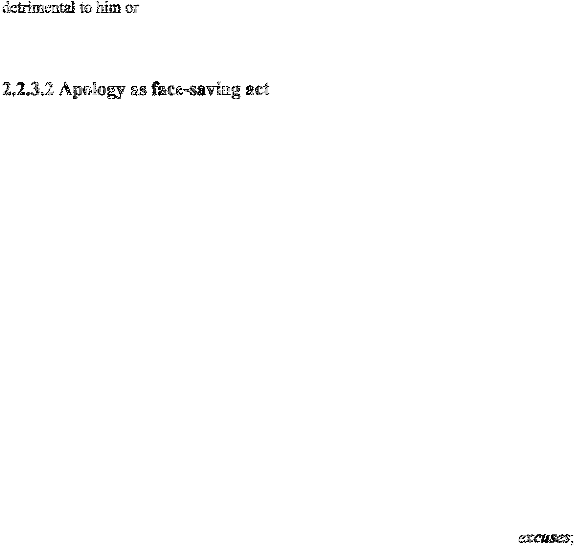
l6
runendments
action
toward (hearer)
because
cfthe violation
cansed by
S
(speaker)
is
Apoiogy,
as
stated
before,
is
called
for
'\\>ben
there
is
a
violation.
It
is
offered
to
express regn:t
having
offi:nded
someone and
tlms
to
restore
the relationship
into
harmony, or in other
words, it serves as social
function (Trosbcrg., 1994:374).
FtLc'ihem1ore,
Trosborg also
mentions
the
elements
involved in
fuce-savitt_g act:
'with
regard
to
a
protective
orientation
toward
saving
the
interlocutor's
face;
and
a
defensive
O"ientation towards
saving
one
owns
face'
(ibid).
It
mea"!S
that
wben ooe
saves
other's
faee
by
expressing
apology,
he
or
she
must
also
save
hls
or
hers
by
givir,g excuse
or
justification.
In
other
words,
apology
is
cor.ducted
to preserve
the
S!JI':akl;;r's
image
wl'-ile
at
the
same
time
rehabilitate
the
relationship.
As
implied
by
Norrie!<, apologies are
made
the
hope
that
Ll]_e addressee
will not
pursue the
mar.er
furtr;,er or
the offender
(Tmsborg,
1994:376).
Austin (1961:173
Owen
1983:93)
disti.11guishes jusdjlcat'.ons
former,
the
speaker accepts
responsibility
for
the
act
but
denies
it
was
bad,
and
in
the
latter,
he
admits
that
it
was
bad
but
doesn't accept
full,
or
even
any,
responsfoility.
:S1rml!rr
ta what
Trosborg
me,nti,om;d
above, Fasold
(1973
Owen
1983:133}
id<;ntific)S
t!rree
intrinsic
conditions on apology:
a. The spe!!lrer regrets
which he is ar'Ologizing
b.
spesier aelmmvledges responsibility for
act